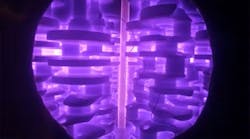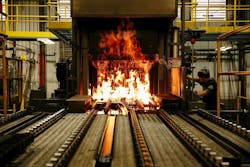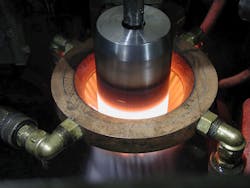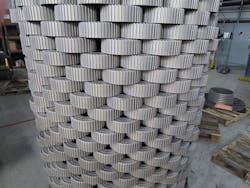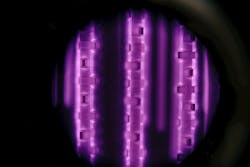This article was updated April 26, 2023. It was originally published Oct. 12, 2018.
Heat treatments let engineers and metallurgists tailor the properties of metal parts so that they are a better fit for specific applications. But to get the most out of these heat treatments, engineers should be familiar with their finer details.
But there are many different heat treatments, including quenching, tempering, aging, stress relieving and case hardening. To eliminate confusion, here’s a look at the most common ones, many of which involve steel.
Annealing
In the annealing process, steel is heated to a state of equilibrium (as defined by its phase diagram). It changes the metal’s physical properties such as its hardness, but there can also be local chemical changes, depending on phase transitions. Annealing treatments are usually done after machining processing such as grinding and even after other heat treatments such as quenching.
Quenching and tempering. In quenching, steel is heated to above its critical temperature and held there until the microstructure fully changes to an austenite phase. The steel is then quenched, a process of rapidly cooling the steel by placing it in water, oil or a polymer solution to “freeze” its microstructure. The liquid used for quenching determines the cooling rate of the hot metal which, in turn, determines what the steel’s microstructure will be after it is quenched. The metal’s time-temperature-transformation diagram (TTT diagram) predicts whether the resulting microstructure will be martensite, bainite or pearlite.
Steel becomes extremely hard and brittle after quenching, so it typically undergoes another step, tempering, to lower its hardness and raise its ductility.
Tempering heats steel to a point below its critical temperature so that it retains its martensitic structure. If tempered long enough, however, it gets converted to a mix of ferrite and small carbides; the size of the carbides depends on the tempering temperature. Tempering temperature and time are precisely controlled as they determine the metal’s final hardness. In general, tempering makes steel softer and more ductile. But lower tempering temperatures let the steel retain its hardness while removing internal stresses; higher temperatures reduce hardness.
Parts made out of quenched and tempered steel can have the tailored hardness and strength for the applications they are designed for. Parts can then be machined to their final state. Quenching and tempering distorts metal, so parts always go through both treatments prior to final machining. Even for parts that go through more heat treat processes to modify surface properties, quenching and tempering determine a part’s core properties such as hardness, strength and ductility.
Stress relieving. Stress relieving, an annealing step, follows grinding, cold working, welding and final machining. It is also done after the metal has been quenched and tempered to the desired microstructure and strength. This means special consideration must be given to ensure workpieces are not annealed (stress relieved) too closely to their tempering temperatures. This prevents the previously achieved hardness and microstructure from changing.
Stress relieving removes internal dislocations or defects, making the metal more dimensionally stable after final processing. Stress relieving is not supposed to change the metal’s physical properties; changes to hardness and strength are, in fact, unwanted.
Precipitation hardening. Precipitation hardening is an annealing step (also known as age hardening) that strengthens the metal. It is only used on parts that have been quenched and are an over-saturated solution, meaning the metal is in a non-equilibrium state with regard to the phases present.
In these alloys, the over-saturated martensite is heated to between 932° and 1,022°F (500° to 550°C) and held for 1 to 4 hours. This lets precipitates uniformly nucleate and grow. It results in a non-distorted steel with high tensile and yield strength with better wear properties than before it was hardened.
Not all ferrous alloys benefit from hardening. However, martensitic stainless steels such as 17-4, 15-5, and 13-8 are excellent candidates, as well as maraging steels. (The term “maraging” combines the words “martensitic” and “aging.”) Those steels have superior strength and toughness without losing malleability, but they cannot hold a good cutting edge.
Induction hardening. Induction hardening is much like quenching, with one distinct difference: Heating in induction hardening is selective. That’s because in induction hardening, heating is done by magnetic coils designed to match the part’s geometry. This lets critical part features be hardened but not the core. Instead, the core retains the metal’s strength and ductility.
Induction hardening can be done on steels with a carbon content greater than 0.3wt%, as well as on parts with sizes and geometries for which engineers can design suitable induction coils. Induction hardening also significantly reduces processing times needed to harden parts and decrease the risk of decarburization. Unlike traditional heating and quenching, induction is a surface-limited heat treatment with hardened depths ranging from 0.5 to 10 mm.
READ MORE: Prevent Future Damage with Proper Surface Treatments
Case Hardening
Case hardening heat treatments, which includes nitriding, nitrocarburizing, carburizing and carbonitriding, alter a part’s chemical composition, unlike annealing. It focuses on surface properties and creates hardened surface layers from 0.01 to 0.25 in. thick, depending on processing times and temperatures. It costs more to make the hardened layer thicker due to longer processing times, but the part’s extended wear life can quickly justify the additional costs.
Carburization and carbonitriding. Carburization is well-suited for parts that need more surface hardening for wear resistance but also need a softer core for strength. It is a high temperature process 1,650° to 1,740°F (900° to 950°C) that adds and diffuses carbon into the steel. Those temperatures are above steel’s critical temperature, so subsequent quenching turns the carbon-rich surface into hard martensite while the core remains a softer ferrite and/or pearlite structure. The thickness of the hardened layer depends on how long parts soak at carburization temperatures.
Carburization makes hard, durable parts from lower-cost alloyed and low carbon steels, such as 1008, 1018 and 8620. For alloys with carbon content above 0.3wt%, the treatment could backfire, with the carbon in the original alloy combining with the additional carbon making the entire part hard and brittle martensite. There would be no softer inner core. It should also be noted that the heat of the process can distort parts.
Adding nitrogen, carbonitriding, can increase hardness in lower carbon steels that lack enough alloying elements that promote hardening. Carbonitriding is commonly carried out at temperatures slightly lower than those for carburizing, so parts don’t distort as much, but it takes more time to make equally thick layers. Surfaces created by carbonitriding are thinner, but compared to those made by carburization, they are harder and better resist high processing temperatures such as in tempering and stress relieving.
Nitriding and nitrocarburizing. The alternatives to the high temperatures of carburizing and carbonitriding are nitriding and nitrocarburizing. They also produce hardened surface layers and similar wear resistances, but they diffuse nitrogen throughout the surface layer (not carbon).
Typical temperature ranges for nitriding range from 840° to 1,070°F (450° to 575°C), which are sub-critical processing temperatures. This means parts can be processed in their final machined state and undergo little to no distortion, so little if any post-nitriding machining is required. The lower temperatures also keep the right core microstructure and physical properties while modifying the surface layer for the given application. One recommendation when selecting nitriding: Tell the heat treater about any stress relief, aging or tempering temperatures to prevent altering core properties.
Unlike carburization, which is limited to lower-carbon-content steels, a broad range of alloys can be nitride to have surface hardnesses of 600 to 1,200 Hv via. But steel alloys best suited for nitriding typically contain nominal amounts of the microalloying elements: Cr, V, Ti, Al and Mo. Nitriding can significantly improve stainless and tool steels containing more than (10wt%) of chromium. Nitrided steels can also have surface hardness well above 70 HRC, perfect for long-term wear resistance.
Nitriding is not limited to only these ferrous alloys, either; low carbon steels can be hardened as well. In addition to creating a hardened, wear resistant surface, nitriding also forms a compound zone—nitrogen-rich layers formed on the surface which are hard, wear-resistant (>60 HRC equivalent) and resist corrosion. This lets low carbon and low alloyed steels be considered for harsh environments.
Depth of hardening for nitride and nitrocarburized alloys typically ranges from 0.005 to 0.030 in., depending on the process’s time and temperatures. Deeper hardened layers require more time. Compound zone thicknesses can be up to 0.002 in., and it’s a function of the alloy being nitrided, along with time and temperature. Depth of the zone also depends on which nitriding method is used: gas or ion (plasma).
Gas nitriding uses cracked ammonia as the source of nitrogen ions and is done under positive pressure. It is well-suited for large quantity batch processing and puts uniform surfaces on parts with deep holes or channels. Gas nitriding is not recommended for porous parts because gas flow through the pores can cause severe embrittlement.
Ion nitriding is best for selectively nitriding as it lets parts be masked off from the ions (plasma) to prevent nitriding. It is done by applying a potential electrical difference across an anode and the part (the cathode) in a vacuum. This potential difference forms a glowing, purple nitrogen plasma which forces nitrogen ions into the part’s exposed surfaces.
Plasma nitriding is well-suited to alloys, such as stainless steels, since it quickly breaks down passive oxide surfaces. Typically, ion nitrided steels have thinner compound zones than gas nitrided parts due to the plasma’s constant sputtering. But this can be an advantage for some applications, such as gears, where contact stresses could harm surfaces with too many compound zones.
Nitrocarburizing is typically performed at temperatures above 1,070°F (575°C) and a source of carbon is used. The added carbon forms a harder, more wear-resistant layer. It can also form thicker compound zones, and the layer is harder and more wear resistant than those created using nitriding. But nitrocarburizing can increase porosity, which is bad for parts with large contact stresses. The resulting layer is also less ductile.
It is important for engineers to consider the following questions when planning on using heat treatments: What forces will the parts be subjected to? What environment will they be in? Does the application require distinct properties for the surface, core or particular surface regions?
This was written by Rich Johnson (materials & process manager), Edward Rolinski (sr. scientist), and Mike Woods (president) at Advanced Heat Treat Corp.
